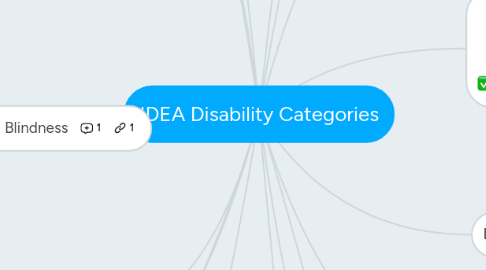IDEA Disability Categories
by Kip Daly

1. Developmental Delay
1.1. behind his or her peers physically, intellectually, socially, emotionally, and behaviorally
1.2. Intervention - breaking down tasks into simpler steps, using visual timers, having a 'friend book',
2. Intellectual Disability
2.1. having sub-average general intellectual functioning with deficits in adaptive behavior
2.2. Intervention - practicing skills in different environments for generalization, behavior specific praise, practicing functional communication, using social stories, using gestures to enhance explanation, using less words when explaining, teaching daily living skills, having a visual schedule of the day's activities
3. Multiple Disabilities
3.1. a combination of two disorders that cause severe education needs, deaf-blindness is not included
3.1.1. Intervention - becoming aware of the needs of the student, becoming familiar with each disability that the student has, using assistive technology (for example, communication boards)
4. Other Health Impairment
4.1. having limited strength, vitality, or alertness that adversely affects a child's educational perfomrance
4.2. Intervention - can be wide-ranging, teacher needs to become aware of the specific issues, and early intervention is best
5. Visual Impairment Including Blindness
5.1. both partial sight and blindness affecting educational performance
5.2. Intervention - using recorded text, braille text, slanted boards for reading text, receiving copies of larger text for presented material, using clear and dark copies for assisgnments
6. Specific Learning Disability
6.1. having one or more psychological processes involved in understanding or using language or doing mathematical calculations
6.2. Intervention - using audio books, on-screen keyboards, using illustrations to accompany readings, stressing phonics rules, chunking together information for memory recall
7. Traumatic Brain Injury
7.1. an injury to the brain caused by an external force, resulting in psycho-social impairment or partial or total functional disabiliity
7.2. Intervention - breaking steps down into simpler steps, using DTI model with providing immediate feedback, giving clearly stated (visualized) instructions, providing praise when completes assignments, having access to breaks in class
8. Smiley face = Case study
9. Websites for Special Education
10. Autism
10.1. affects verbal and nonverbal communication
10.2. Intervention - ABA (Applied Behavior Analysis) including graphing progress of skills, using visual prompts to build up social skills; using Ipad apps with picture communication features
11. Deaf-blindness
11.1. simultaneously hearing and visually impaired
11.2. Intervention - Speech pathologist focuses on verbal, nonverbal, and oral skills (i.e. drinking), in addition to support on sign language, braille, verbal output devices
12. Deafness
12.1. severe hearing impairment
12.2. Intervention - using personal hearing devices with sound-field FM system, having less visual distractions in class, using captioning or scripts, frequent checking for understanding
13. Emotional Disturbance
13.1. inability to learn that is related to lack of having social relationships, inappropriate behavior, unhappiness, and sickness related to negative associations with school and personal problems
13.2. Intervention - using self-monitoring checklists, receiving psychological counseling, making clear indications of what is happening in the classroom, working gradually towards group activities, being sensitive when creating group work activities
14. Hearing Impairment
14.1. can be permanent or fluctuating; not under the definition of "deafness"
14.2. Intervention - provide transcripts of audio material, use visual prompts, have tiered instructions that are not complicated
15. Orthopedic Impairment
15.1. impairments cause by disease or physical impairments
15.2. Intervention - having special furniture for the student, having class helpers for the student, having writing tools for the student (for example, pencil grips)
16. Speech or Language Impairment
16.1. communication disorder that affects educational performance
16.2. Intervention - use tactile and visual cues, incorporate individual vocabulary into the unit, using computer/Ipad apps to reinforce lessons, provide visual cues and gestures for the student
17. Technology to use for IDEA students


